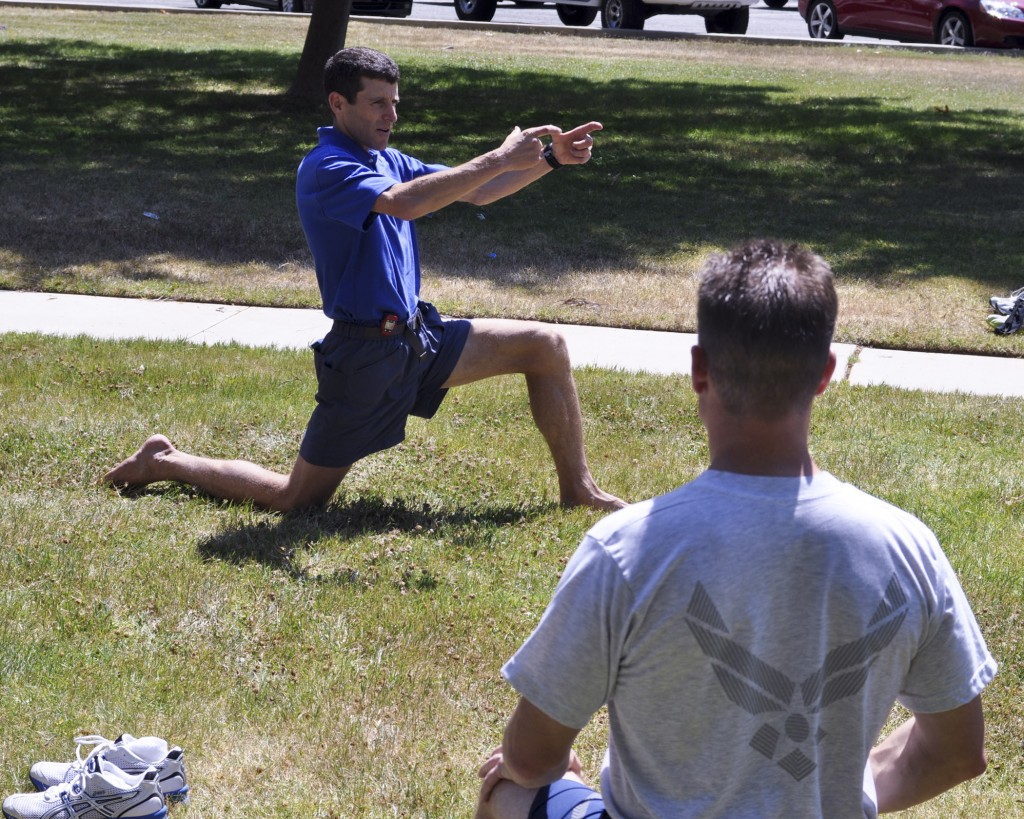This is a nice stretch for hip extension which critical joint mobility for efficient running. Most of us sit all day which shortens the iliacus, psoas, and hip flexor mechanism. To run with efficient elastic recoil, the upper leg most be able to extend behind the hips and naturally recoil forward.
Notice my fingers forward. this indicates that the direction of the ASIS- Anterior Superior Iliac Spine (bony things you feel on top of pelvis in front) should be forward at all times like headights. You do not want your pelvis to tilt forward (like a bucket spilling).
To do the stretch:
Start from a kneeling lunge.
Tighten your glutes in your back leg as you bend your front knee and stretch the hip flexors in your back leg

Make sure to keep your torso upright (don’t lean forward!). You should feel a stretch in the front of your hip, often this stretch continues into your abdomen.
Hold the stretch for 2 seconds and repeat 10 times with each leg.
You can also hold this stretch for 30 seconds for one or two times.
Please note this cautionary reminder: Never stretch before you run! Do this stretching drill after running or remote from running activity.


Glad to see that you’re recommending holding the stretch for 2 seconds and repeating 10 times. Holding a stretch for greater than 2 seconds can, more often than not, trip the stretch reflex and cause the muscle to contract while you’re trying to stretch it. Far too often the ‘stretch’ a person feels when stretching is, in all actuality, a tug of war. The muscle is contracting to protect itself while the person is trying to lengthen it. This results in less blood flow to the muscle tissue. A benefit of stretching using the 8 to 10 reps of two second stretches technique, pumps blood thru the tissues thereby warming up the tissues for movement.
To gain more specificity in the stretch you can start with the knees hip width apart and do 8 to 10 reps of 2 second gentle stretches. After that move the back knee in (medial) about one knee width and repeat. Then you can move the back knee medial one more knee width for another series of 8 to 10 reps (2 seconds each).
It’s also important to remember that excess tension in the quads can also ‘pull on’ the hip flexors limiting their movement.
I have to disagree with the idea of short hold stretches. Sarah indicates the myotatic reflex (stretch reflex) can kick in if stretches are held longer than 2 secs. This is a monosynaptic reflex and can occur in 1-2 milliseconds. Holding stretches beyond the time point of the stretch relex (> 30 secs) is a much more affective way to enhance flexibility. That being said, such stretches should not be undertaken inside an hour of activity. However, some recent studies have shown that static long hold stretches an hour from activity (esp explosive activity) may enhance performance.
“Excess tension” in the quads doesnt really pull on the hip flexors (im gathering Sarah meant psoas/iliacus). In reality “excess tension” in Rectus Femoris and Sartorius can potentially limit hip extension do to shortened muscle length. This however is starting to be believed to be a fascial limitation vs a true muscle shortening.
Geoff,
great response and you are right. Really dynamic movements like swings and actually stretch while running…opening up the stride at the end of a run in realxed way are great for mobility. over 30 seconds optimal as you say for a static type stretch as long as not before a run. Like holding a yoga pose.
thanks for sharing the knowledge…we are all just learning the magic of fascial fitness.
Mark
I’ve been told my whole life to practice static stretching before running. What is the argument against doing this?
Thanks!
Chris static stretching before running shuts off motor units and causes micro injury. power is less.
Mark
Thanks Mark! What would you recommend doing instead? Would some kind of warm up be good, or should I just hit the road right away?
Chris…light easy jog to get the fascia warm and loose and then some dynamic warmup such as light skips and strides to get the range of motion to full. Mark
Another great way to add pliiability to the soft tissue is to use a foam roll or small ball to self massage the tissue.
A year ago at work I had all my desks/counters raised to 45″, this was part of my strategy to strengthen my legs and glutes. What an improvement, I recommend that everyone do this. A chance to train while I’m working has made me a faster runner.
Dear Mark,
You’re amazing—thanks for all you do. Any tips for Iliotibial Band Syndrome? Clearly I need to strengthen the hips and core but now that it hurts, how do I get back to running?
Thanks.
Troy thanks for the note. often is is stability of the foot and hip which leads to stress of ITB. knee caves in for many on landing and mid stance. where do you live? maybe there is someone i know who is close and can help